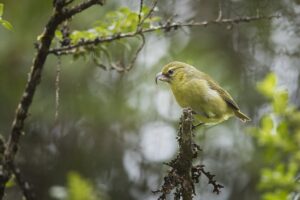Malaria is considered to be one of the most prevalent (and deadly) diseases known to humanity, with almost half the world’s human population at risk of infection. According to the WHO, in 2022 alone, there were 249 million cases of malaria infection and 608 000 deaths globally. However, malaria is a disease that affects other primates, birds, bats, antelopes and lizards too, and its impact on animal populations can be equally devastating – even leading to species extinction.
In Hawaii, where malaria has not been seen until relatively recently, when it was introduced by humans in the early 1800s, the native animal species are particularly vulnerable because they have not evolved much immunity to the parasite.
In particular, malaria has had a severe impact on bird populations. For example, only 17 of the 55 species of Hawaiian honeycreeper birds remain today, and malaria (specifically Plasmodium relictum) is considered to be the main cause of their extinction. Honeycreepers are an important part of the local ecosystem, helping to pollinate plants and controlling insect populations, so losing these birds will have a much wider impact on the islands than just losing these beautiful creatures.
Unfortunately, with warming temperatures, high altitude ‘safe zones’, where malaria spreading Culex mosquitoes have hitherto not been able to reach, are disappearing. On the island of Kauaʻi, climate change has already effectively sent the native honeycreeper species known as ‘akikiki’ into extinction with only one bird remaining in the wild in 2024 (there had been 450 individuals in 2018 – showing how rapidly malaria can kill these bird populations).

On Maui, the population of kiwikiu (another species of honeycreeper) are similarly dwindling. However, conservationists are looking for ways to fight back and save the remaining honeycreeper species. Initially traditional conservation methods were having limited effect, so they have turned to a non-traditional method: the incompatible insect technique.
As crazy as it sounds, this involves releasing male malaria mosquitoes into the wild to mate with wild female mosquitoes. But there is something unique about these male mosquitoes: they have been lab bred and infected with Wolbachia – bacteria that live within insects and prevent their eggs from hatching.
Male mosquitoes do not bite, and so cannot transmit malaria, and so releasing lab-bred mosquitoes infected with Wolbachia into the wild to compete with wild male mosquitoes should be a safe form of biological control. And as female mosquitoes mate only once, introducing infected male mosquitoes to mate with them, would prevent any eggs they lay from hatching and consequently stop new generations of mosquitoes from developing. Potentially, there could be other mechanisms through which Wolbachia reduce malaria transmission, such as reducing the number of viable parasites carried by mosquitoes, but these were not discussed in the reports by the National Parks Service.

Using drones or helicopters, 250,000 lab-bred infected mosquitoes are being released weekly in biodegradable pods over Haleakalā National Park in Maui. This has been an ongoing project since November 2023 and, so far, 10 million mosquitoes have been released into the wild. This despite a legal challenge to stop this project in February 2024. The plan is to release these mosquitoes over a larger area.
Looking into the future, there have been studies looking at the gut microbiome of honeycreeper species that have shown some resistance to malaria that could eventually be used to develop potential conservation strategies, but for now, Wolbachia-infected mosquitoes seems to be one of the best hopes for these birds.


Comments